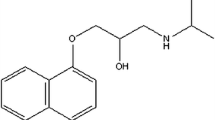Summary
In 17 lithium-treated patients with manic-depressive disorders and 11 healthy subjects the concentrations of choline, phosphorylcholine, cytidyldiphosphate choline, lipid bound choline, and glycerophosphorylcholine were measured in plasma and erythrocytes. Plasma levels of high density, low density, and very low density lipoproteins were also estimated as well as the concentrations of 4 free fatty acids. Free choline (more than 10-fold) and phosphorylcholine (2-fold) were significantly increased in erythrocytes of lithium-treated patients as compared to the healthy untreated controls. Differences in the other substrates were not significant. Osmotic resistance of the erythrocytes was not changed during lithium treatment. Inhibition of the choline flux across the erythrocyte membrane in vitro from lithium-treated patients was not abolished by equilibration of the concentration gradient. It is concluded that the accumulation of choline in erythrocytes from patients on lithium therapy may be due to trapping of lipid derived choline because of an alteration in membrane permeability and not to increased breakdown of phosphatidylcholine.
Similar content being viewed by others
References
Begemann H (1982) Praktische Hämatologie. 8. Auflage. Thieme, Stuttgart New York, S 419–420
Brockerhoff H, Jensen RG (1974) Lipolytic enzymes. Academic Press, New York San Francisco London, pp 235–243
van Calker C, Greil W (1986) Biochemische und zellphysiologische Effekte von Lithiumionen. In: Müller-Oerlinghausen B, Greil W (eds) Die Lithiumtherapie — Nutzen, Risiken, Alternativen. Springer, Berlin Heidelberg New York
Chapman BE, Beilharz GR, York MJ, Kuchel PW (1982) Endogenous phospholipase and choline release in human erythrocytes: A study using1H NMR spectroscopy. Biochem Biophys Res Commun 105: 1280–1287
Grossman CH, Horky J, Kohn R (1966) In vitro incorporation of32P-orthophosphate into phosphatidylethanolamine and other phosphatides by mature human erythrocytes ghosts. Arch Biochem Biophys 117: 18–27
Hanin I, Mallinger AG, Kopp U, Himmelhoch JM, Neil JF (1980) Mechanism of lithium-induced elevation in red blood cell choline content: An in vitro analysis. Commun Psychopharm 4: 345–355
Jenden DJ, Jope RS, Fraser SL (1980) A mechanism for the accumulation of choline in erythrocytes during treatment with lithium. Commun Psychopharm 4: 339–344
Joos C, Kewitz H, Reinhold-Kourniati D (1980) Effects of diuretics on plasma lipoproteins in healthy men. Eur J Clin Pharmacol 17: 251–257
Jope RS, Jenden DJ, Ehrlich BE, Diamond JM (1978) Choline accumulates in erythrocytes during lithium therapy. N Engl J Med 299: 833–834
Kewitz H (1959) Nachweis von 4-Amino-n-butyrylcholine im Warmblütergehirn. Naunyn-Schmiedebergs Arch Exp Pathol Pharmakol 237: 308–318
Kewitz H, Pleul O (1977) Inhibition of choline incorporation into brain lipids in rats by urethane, a proposed mechanism of depression of the central nervous system. Naunyn-Schmiedebergs Arch Pharmacol 298: 205–210
Klöppel A, Post D, Schneider G, Schütz H (1970) Abtrennung quartärer Ammoniumverbindungen über zerlegbare Ionenpaarextrakte mit nachfolgender Identifizierung. Fresenius Z Anal Chem 252: 279–284
Lee G, Lingsch C, Lyle PT, Martin K (1974) Lithium treatment strongly inhibits choline transport in human erythrocytes. Br J Clin Pharmacol 1: 365–370
Lingsch C, Martin K (1976) An irreversible effect of lithium administration to patients. Br J Pharmacol 57: 323–327
Martin K (1972) Extracellular cations and the movement of choline across the erythrocyte membrane. J Physiol 224: 207–230
Müller-Oerlinghausen B (1977) 10 Jahre Lithium Katamnese. Nervenarzt 48: 483–493
Mulder E, van Deenen LLM (1965) Metabolism of red cell lipids. III. Pathways for phospholipid renewal. Biochim Biophys Acta 106: 348–356
Pleul O, Müller-Oerlinghausen B (1984) On the effect of lithium salts on choline levels in human erythrocytes. Naunyn-Schmiedeberg's Arch Pharmacol 325: R 61
Schill G, Danielsson B (1959) Photometric determination of quarternary ammonium compounds with hexanitrodiphenylamine I. Anal Chim Acta 21: 248–254
Stone WE (1955) Acetylcholine in brain. I. “Free”, “bound”, and “total” acetylcholine. Arch Biochem 59: 181–192
Ziemsen B, Agarwal DP, Hoo JJ, Goedde HW (1983) The effect of lithium, imipramine and chlorpromazine on the membrane-bound enzyme phosphatidylethanolamine methltransferase. Arzneimittelforsch/Drug Res 33: 1523–1524
Author information
Authors and Affiliations
Additional information
Dedicated to Professor Helmut Kewitz on the occasion of his 65th birthday
Rights and permissions
About this article
Cite this article
Pleul, O., Müller-Oerlinghausen, B. Lithium therapy and the turnover of phosphatidylcholine in human erythrocytes. Eur J Clin Pharmacol 31, 457–462 (1986). https://doi.org/10.1007/BF00613524
Received:
Accepted:
Issue Date:
DOI: https://doi.org/10.1007/BF00613524



